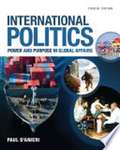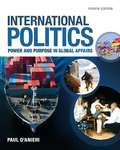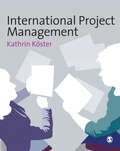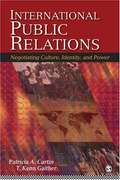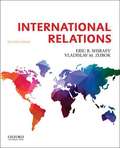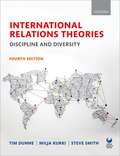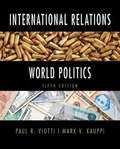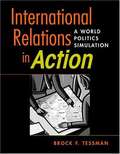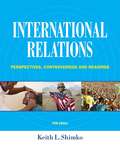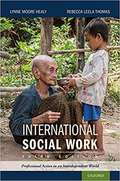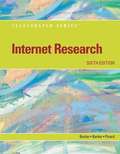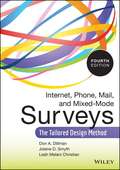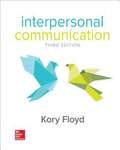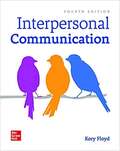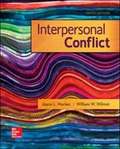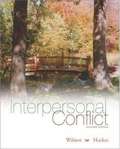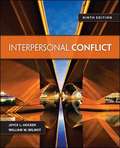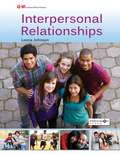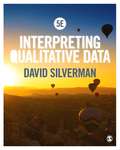- Table View
- List View
International Politics: Power And Purpose In Global Affairs
by Paul D'AnieriD'Anieri's INTERNATIONAL POLITICS: POWER AND PURPOSE IN GLOBAL AFFAIRS, 5th Edition, helps you make the connection between academic theories and real-world issues and events. Comparing international politics to a series of intellectual puzzles, the text emphasizes the importance of examining problems from multiple perspectives. Its unique focus on power and purpose involves both the goals that players have in international politics and the ways they have to achieve them. Detailed, up-to-date discussions cover populism and trade wars, critical international relations theory, international hierarchy, the impact of social media and bias, Brexit, U.S.-China trade conflict and much more. Thought-provoking case studies and features on history, policy and geography let you see the world from numerous perspectives while sharpening your critical thinking skills. Also available: MindTap.
International Politics: Power And Purpose In Global Affairs (Fourth Edition)
by Paul D'AnieriINTERNATIONAL POLITICS: POWER AND PURPOSE IN GLOBAL AFFAIRS, 4th Edition, helps you make the connection between analytical theories and real-world issues and events. The focus on power and purpose engages both the goals that actors have in international politics, and the ways they have to achieve them. Thought-provoking case studies and features on history, policy, and geography let you see the world from multiple perspectives, while critical-thinking questions for each feature ask you to examine what you have learned. The Connection to You boxes show how international politics directly affects the lives of individuals, and how individuals can influence international politics.
International Project Management
by Kathrin KosterWith project management becoming an increasingly global endeavour, a comprehensive and international student text that reflects this reality is essential.<P> International Project Management does just that, systematically linking the key elements of cross-cultural management and the particularities of an international context, with the tools and techniques of project management.<P> Key features include:<P> - A wide variety of examples and illustrations, including an in-depth, end-of-chapter case study with case questions;<P> - Student exercises and review questions;<P> - Detailed further reading<P> - The full support of a Companion Website, featuring a Teacher's Manual<P> Visit the Companion Website at www.sagepub.co.uk/koster
International Public Relations: Negotiating Culture, Identity, and Power
by Patricia A. Curtin T. Kenn GaitherInternational Public Relations: Negotiating Culture, Identity, and Power offers the first critical-cultural approach to international public relations theory and practice. Authors Patricia A. Curtin and T. Kenn Gaither introduce students to a cultural-economic model and accompanying practice matrix that explain public relations techniques and practices in a variety of regulatory, political, and cultural climates. offers the first critical-cultural approach to international public relations theory and practice. Authors Patricia A. Curtin and T. Kenn Gaither introduce students to a cultural-economic model and accompanying practice matrix that explain public relations techniques and practices in a variety of regulatory, political, and cultural climates.
International Relations
by Vladislav M. Zubok Eric B. ShiraevUsing a three-part framework of Ideas, Arguments, and Contexts and Applications, International Relations, Second Edition, shows students how to think critically about issues and current events in world politics. Each chapter first describes key concepts and developments in the field (Ideas), then presents the main theoretical and analytical approaches (Arguments), and finally applies the main theories and approaches within the individual, state, and global contexts (Contexts and Applications). Historical information is woven throughout the text, and every chapter ends with an extended case study ("The Uses of History") that demonstrates how what we have learned from the past can influence our future actions. Three full chapters on key approaches--realism (chapter 2), liberalism (chapter 3), and constructivism and other alternative views (chapter 4)--introduce students to a broad spectrum of approaches, and each chapter integrates discussions of relevant theories and levels of analysis. Visual Reviews at the end of each chapter not only recap key points but include Critical Thinking questions that reflect the chapter learning objectives.
International Relations Theories: Discipline and Diversity (Fourth Edition)
by Steve Smith Tim Dunne Milja KurkiBringing together the most influential scholars in the field, International Relations Theories: Discipline and Diversity provides unrivalled coverage of international relations theories and arguments. This best-selling text explores the full spectrum of theoretical perspectives and debates, ranging from the historically dominant traditions of realism, liberalism, and Marxism to postcolonialism and green theory. Each chapter is dedicated to a particular theory and features a case study that bridges theory and practice, showing how theory can be used to explain real world political dilemmas. Spotlights on key books and articles encourage readers to go beyond the textbook and explore important works in the field, and new case study questions encourage analytical thinking and help readers understand the value of applying theory to concrete political problems.
International Relations and World Politics
by Paul R. Viotti Mark V. KauppiUpdated in its 5th edition, International Relations and World Politics is a toolkit that offers an authoritative survey of the field and practical ways to analyze current and future world problems. Drawn from the authors’ experience as scholars and practitioners, this new edition was completely rewritten to focus on an enduring teaching and learning goal–how individuals can apply theory, history, geography, and more for a lifetime of understanding politics in a globalized world. Whether as actors themselves in world politics, participants in the global economy, or simply readers of world news, those reading International Relations and World Politics not only get more help to master the field’s concepts but also get more help to understand that these are real-world ideas with real-world implications.
International Relations in Action: A World Politics Simulation
by Brock TessmanThis hands-on exercise allows students to relate the concepts and issues at the foundation of global politics to the realities of international politics today. As influential leaders in the fictional world of Politica, each team of students governs a country with a unique history, geography, and culture. The teams must use strategy and negotiation to succeed - and survive - seeking to achieve specific territorial, security, and economic objectives. In the process, they grapple with a range of complex challenges: energy security, ethnic conflict, humanitarian intervention, environmental disaster, terrorism, nuclear proliferation, and more. Students also pursue individual objectives based on the governmental post they hold - and quickly learn that self-interest and national interest are not always compatible. Teams are judged on their effectiveness in meeting stated objectives, but must also relate their practical experience to the academic content of the course. Toward this end, the book provides summaries, analysis, study questions, and additional sources of information for each of the theories and issues encountered during the simulation. Guidelines for instructors are also included. "International Relations in Action" has been tested in multiple courses, with students and instructors unanimously agreeing that it makes abstract theories practical and accessible, evokes an appreciation for the complexity of international politics, and generates enthusiasm for the study of international relations. In the representative words of one student, "It was the best learning experience I've ever had."
International Relations: Perspectives, Controversies and Readings (Fifth Edition)
by Keith L. ShimkoEngaging and highly accessible, this reader-friendly text features broad coverage of key principles of international relations, providing a thorough introduction to the discipline while avoiding excessive detail and complexity. International Relations: Perspectives, Controversies, and Readings, Fifth Edition, explores essential concepts such as power politics, war and democracy, human nature, free trade, inequality, globalization, humanitarian intervention, and terrorism. Each chapter features brief, topical coverage presented within a debate framework, challenging you to think critically, consider diverse perspectives, and apply what you have learned to real-world scenarios. The author also includes current, relevant primary source readings, giving you firsthand exposure to the materials and ideas shaping international relations today. Thoroughly revised, the Fifth Edition of this popular text features updated content in nearly every chapter, including the most recent statistics, research, trends, theories, and examples drawn from today's headlines, including chemical weapons in Syria, the conflict between Russia and Ukraine, and the debate over climate change and global resources.
International Social Work: Professional Action In An Interdependent World
by Lynne Moore Healy Rebecca Leela ThomasInternational Social Work: Professional Action in an Interdependent World, Third Edition, is a comprehensive treatment of all dimensions of international social work. The authors' four-part framework includes domestic practice and policy influenced by global forces, professional exchange, international practice, and global social policy. The first section of the book explores globalization, development and human rights as foundational concepts for international social work. The text then provides an overview of global social issues and international organizations related to social welfare. Part II offers an overview of the global history of the profession. Similarities and differences in social work around the world are examined through seven country examples. Part III provides an extensive discussion of current aspects of the global profession, with chapters on ethics, social policy, international development practice, and practice at the international/domestic interface. Modalities of international professional exchange are then explored prior to a concluding chapter that provides recommendations for international action. The text is enlivened by numerous case examples, drawn from many parts of the world. The history chapters include brief biographies of noted social workers on the international scene whose accomplishments serve as inspiration for readers. The text is extensively referenced with updated professional literature and intergovernmental documents. Carefully selected items in the appendix expand the usefulness of the book.
International Trade: Theory and Policy
by Steve SuranovicInternational Trade: Theory and Policy is built on Steve Suranovic's belief that to understand the international economy, students need to learn how economic models are applied to real world problems. It is true what they say, that "economists do it with models." That's because economic models provide insights about the world that are simply not obtainable solely by discussion of the issues. International Trade: Theory and Policy presents a variety of international trade models including the Ricardian model, the Heckscher-Ohlin model, and the monopolistic competition model. It includes trade policy analysis in both perfectly competitive and imperfectly competitive markets. The text also addresses current issues such as free trade area formation and administered protection policies. The models are developed, not by employing advanced mathematics, but rather by walking students through a detailed description of how a model's assumptions influence its conclusions. But more importantly, each model and theory is connected to real world policy issues. The main purpose of the text is to provide a thorough grounding in the arguments concerning the age-old debate about free trade versus protectionism.
Internet Research (Sixth Edition)
by Katherine Pinard Donald Barker Melissa BarkerThis book is an ideal learning tool for a wide range of learners. It provides essential information about Internet research, including topics on search toolbars, intelligent search agents, and finding, evaluating and citing online sources.
Internet, Phone, Mail, and Mixed-Mode Surveys: The Tailored Design Method (Fourth Edition)
by Don A. Dillman Leah Melani Christian Jolene D. SmythThe classic survey design reference, updated for the digital age For over two decades, Dillman's classic text on survey design has aided both students and professionals in effectively planning and conducting mail, telephone, and, more recently, Internet surveys. The new edition is thoroughly updated and revised, and covers all aspects of survey research. It features expanded coverage of mobile phones, tablets, and the use of do-it-yourself surveys, and Dillman's unique Tailored Design Method is also thoroughly explained. This invaluable resource is crucial for any researcher seeking to increase response rates and obtain high-quality feedback from survey questions. Consistent with current emphasis on the visual and aural, the new edition is complemented by copious examples within the text and accompanying website. This heavily revised Fourth Edition includes: Strategies and tactics for determining the needs of a given survey, how to design it, and how to effectively administer it How and when to use mail, telephone, and Internet surveys to maximum advantage Proven techniques to increase response rates Guidance on how to obtain high-quality feedback from mail,electronic, and other self-administered surveys Direction on how to construct effective questionnaires,including considerations of layout The effects of sponsorship on the response rates of surveys Use of capabilities provided by newly mass-used media:interactivity, presentation of aural and visual stimuli. The Fourth Edition reintroduces the telephone-including coordinating land and mobile. Grounded in the best research, the book offers practical how-to guidelines and detailed examples for practitioners and students alike.
Internships in Sport Management
by Matthew Walker Robin Ammon Edward E. Seagle Ralph W. SmithIn this book "Internships in Sport Management", students will be introduced to the concept of a "game plan for success" and provided with application exercises to help develop their own personalized plan. This cutting edge how-to-do-it manual is chock-full of real-life examples presented by previous sport management students from across the country. The authors furnish the reader with important ideas for creating an eye-opening cover letter, strategies necessary for a powerful resume, and other indispensable suggestions. The reader will develop a professional attitude and attention to detail that will ensure that the interviewee makes a positive first impression. This textbook is the ultimate tool to prepare a sport management student for that crucial internship in sport event management, intercollegiate athletics, minor league sport, sport facility management, sport marketing, sport/business and sport/entertainment industries.
Interpersonal Communication
by Kory FloydKory Floyd McGraw-Hill Education, 22 May 2012 - Language Arts & Disciplines - 480 pages 0 Reviews Kory Floyd's approach to interpersonal communication stems from his research on the positive impact of communication on our health and well-being. Interpersonal Communication, 2e demonstrates how effective interpersonal communication can make students' lives better. With careful consideration given to the impact of computer-mediated communication, the program reflects the rapid changes of the modern world in which today’s students live and interact. The program also helps students understand and build interpersonal skills and choices for their academic, personal, and professional lives.
Interpersonal Communication
by Kory FloydInterpersonal Communication helps students see how communication not only affects their relationships but also influences their health, happiness, and quality of life. Author Kory Floyd encourages students to go beyond commonsense notions about communication and helps them see the value of investigating interpersonal processes - both face-to-face and online - in a systematic manner.
Interpersonal Communication and Human Relationships
by Anita L. Vangelisti Mark L. Knapp John P. CaughlinThis title introduces students to interpersonal communication principles and theories through the use of commonplace experiences, such as relationships with roommates, friends and co-workers. The book aims to motivate students to critically think about their own relational communication; it also peaks student interest in social science research. <p><p>MySearchLab is a part of the Knapp/Vangelisti/Caughlin program. Research and writing tools, including access to academic journals, help students explore human communication in even greater depth.
Interpersonal Conflict
by Joyce Hocker William WilmotInterpersonal Conflict explains the key dynamics of personal conflicts that we all face. Written for courses such as Communication and Conflict, Interpersonal Conflict, Conflict Management, Conflict and Negotiation, and Conflict in Personal Relationships, this textbook examines the central principles of effective conflict management in a wide variety of contexts--whether at home or on the job. Its combination of up-to-date research and examples gives students a theoretical and practical foundation in conflict management.
Interpersonal Conflict
by William W. Wilmot Joyce L. HockerTextbook examines the central principles of effective conflict management in a wide variety of contexts--from romantic relationships to the workplace. Its combination of up-to-date research and examples gives students a theoretical as well as a practical foundation in conflict management.
Interpersonal Conflict
by William W. Wilmot Joyce L. HockerInterpersonal Conflict explains the key dynamics of personal conflicts that we all face. Written for courses such as Communication and Conflict, Interpersonal Conflict, Conflict Management, Conflict and Negotiation, and Conflict in Personal Relationships, this textbook examines the central principles of effective conflict management in a wide variety of contexts--whether at home or on the job. Its combination of up-to-date research and examples gives students a theoretical and practical foundation in conflict management. Instructors and students can now access their course content through the Connect digital learning platform by purchasing either standalone Connect access or a bundle of print and Connect access. McGraw-Hill Connect® is a subscription-based learning service accessible online through your personal computer or tablet. Choose this option if your instructor will require Connect to be used in the course. Your subscription to Connect includes the following: * SmartBook® - an adaptive digital version of the course textbook that personalizes your reading experience based on how well you are learning the content. * Access to your instructor's homework assignments, quizzes, syllabus, notes, reminders, and other important files for the course. * Progress dashboards that quickly show how you are performing on your assignments and tips for improvement. * The option to purchase (for a small fee) a print version of the book. This binder-ready, loose-leaf version includes free shipping. Complete system requirements to use Connect can be found here: http://www. mheducation. com/highered/platforms/connect/training-support-students. html
Interpersonal Process in Therapy: An Integrative Model (5th edition)
by Edward TeyberThis resource for student therapists explains how to use the therapeutic relationship to help clients change. Using a wealth of real life examples including clinical vignettes and therapist-client dialogues, it demonstrates how the interpersonal process approach works. Sample topics include establishing a working alliance with the client, responding to painful feelings, developing a treatment focus, and terminating the therapeutic relationship. Teyber teaches at California State U. , San Bernardino. Annotation ©2005 Book News, Inc. , Portland, OR (booknews. com)
Interplay: The Process of Interpersonal Communication
by Ronald B. Adler Lawrence B. Rosenfeld Russell F. Proctor IIWith its unique blend of compelling topics and rich pedagogy, Interplay: The Process of Interpersonal Communication, Fifteenth Edition, offers a perfect balance of research and application to help students understand and improve their own relationships. No other book prepares students better to start improving their relationships beginning with the first day of class.
Interpreting Earth History: A Manual in Historical Geology
by Scott Ritter; Morris PetersenThe Eighth Edition of Interpreting Earth History continues a legacy of authoritative coverage, providing the flexibility and scope necessary to engage students with geological data from a variety of sources and scales. The authors carefully review the subjects covered in current historical geology courses and have tailored each stand-alone assignment to offer a clear, straightforward examination of pertinent topics. The content of this classroom-tested laboratory manual has been expanded and enhanced to include exercises on the Precambrian history of the Canadian Shield as well as an understanding of the stratigraphic, structural, and depositional history of North America during the Phanerozoic Eon. Now in full color, students will become more proficient in their ability to see and recognize geological patterns as well as the compositional and textural attributes of rocks and fossils.
Interpreting Qualitative Data: Methods For Analysing Talk, Text And Interaction
by David SilvermanIn this exciting and major updating of one the most important textbooks for beginning qualitative researchers, David Silverman seeks to match the typical chronology of experience faced by the student-reader. Earlier editions of Interpreting Qualitative Data largely sought to provide material for students to answer exam questions, yet the undergraduate encounter with methods training is increasingly assessed by students doing their own research project. In this context, the objective of the Third Edition is to offer undergraduates the kind of hands-on training in qualitative research required to guide them through the process.
